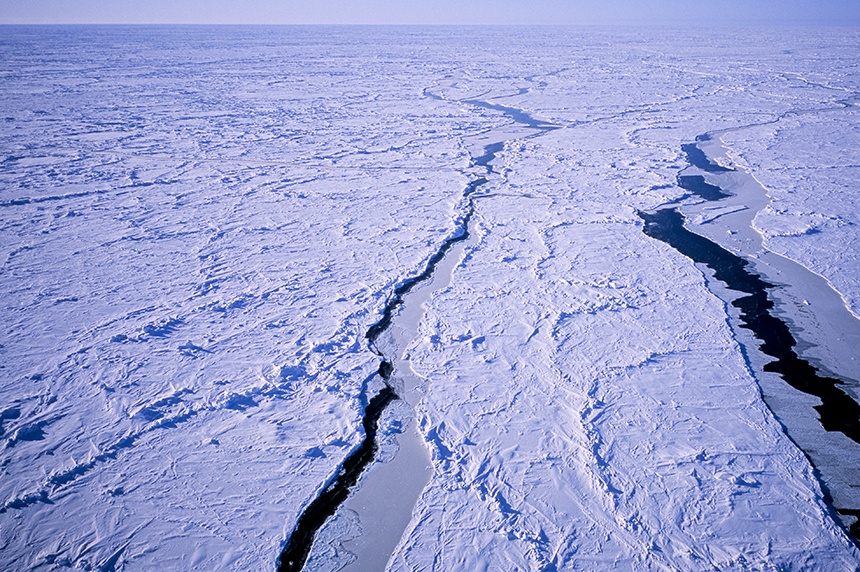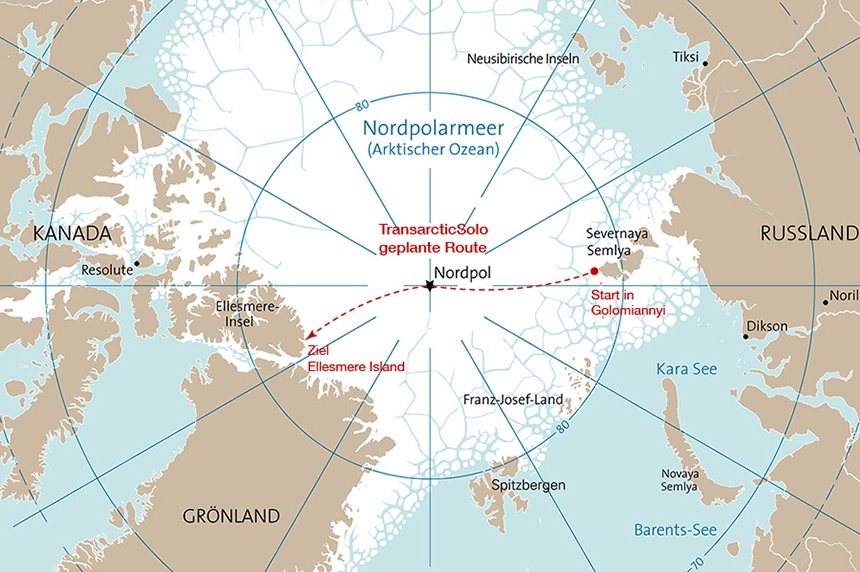Put on ice
I am accustomed to telling my guests on our North Pole expeditions that the Arctic will change their lives. As if I hadn’t had more than enough opportunities in the past to figure this out myself, I realized in April 2015, during my test expedition, that the Arctic hasn’t just shown me everything yet. I’ve always searched for these boundaries, tried to push them a bit further. Transarctic Solo 2016 would have been a project in a class of its’ own. The Arctic Ocean remains the last unconquered ocean. It has yet to be crossed solo by any human being without outside support. 2000 kilometers on skis, alone in the polar wasteland, travelling across highly unpredictable grounds from the Russian to the Canadian coast. My preparation was meticulous; I was determined and willing to complete the impossible. On a test expedition in April 2015, I wanted to move on from the North Pole on my own in order to reconnoiter the second part of my vast project. Just after a few days I came to the conclusion; I don’t want to. I don’t want to push the limits necessary in order to complete the Transarctic Solo 2016. Despite all of my preliminary work and preparation, the answer didn’t come to me until I was out there, all alone on the Arctic Ice: Transarctic Solo 2016 has been put on ice.
My route
Starting Point Cape Arktichesky. The starting point of my expedition is the Russian Cape Arktichesky; also know as the Arctic Cape. The journey there is a minor expedition already and requires a huge amount of organization. 100 days on my own. Starting from the Russian Cape Arktichesky, it will take me approximately 60 days to reach the North Pole. From there, I will need another 30 to 40 days to reach Canadian mainland. Temperatures will plummet down to -45° and the closer the mainland, the harsher the conditions get.
The final destination: Ellesmere Island. After around 90 to 100 days, I will arrive at Ward Hunt Island, a small island just off the coast of Ellesmere, where the rest of the team will be waiting for me. Robert Peary started off on his expedition from here over one hundred years ago. Just as he was the first man to reach the Pole, I will be the first person to cross the ocean completely unassisted.
The Challenge
Solo. That means I’m on my own. Always. I can never ask anyone, never talk to anybody. No laughing, fighting, just being silent or sharing the workload with anyone. I make all decisions. I am my only motivator. Only I carry responsibility. I alone.
Isolated. The closest person is thousands of kilometers away.
Supreme discipline. Solo expeditions trigger high psychological pressure. The use of my satellite phone will be limited to transmitting my coordinates every few days from my tent.
Walking on ice. The Arctic Ocean is moving. In which way is always a surprise to us. General patterns exist; the ice travels with the Transpolar Drift Stream from Siberia to Canada, however, these patterns are not constant. The Drift can change due to wind and high and low pressure systems. This could result in my moving backwards, waking up in the same place I started off the day before, almost like riding an escalator the wrong way.
My preparation
No compromises. I have to be able to start off when I think the time is right, when nature offers optimal conditions. Being this independent has its price.
Evaluation of satellite images. I’ve been collecting information about the conditions along the Siberian coast for years, focusing especially on the time frame in which I will be starting off. A long-term evaluation of the ice is essential for me.
Optimized sleds. The newest innovation: 180kg will be distributed amongst two sleds instead of just one, making the weight easier to handle.
Mental strength. For Transarctic Solo 2016, I have been working together with a mental coach, supporting me presently and throughout the expedition.
Teamwork. Should my start from the coast be postponed once again, I will join my team waiting at the weather station on Golomjanny Island.
My messages
The vision. In searching for true innovation, it is necessary to step outside of the usual boundaries, to think outside of the box. Everyone is capable of creating a new dimension in what they do – taking things to a next level – as I am with Transarctic Solo. It started with a simple thought and the determination to try.
Limits. Boundaries are not merely finish lines but rather a challenge to conquer. The world needs people who push their limits, broadening their horizons while doing so. This is the only way forward.
The first man. It’s not about speed or breaking records in Transarctic Solo, it’s about reaching a goal no one ever has before. To be the first person to cross the last unconquered ocean unassisted. That is the story.
Living a dream. Living a dream means being fully alert at all times. All energy must be put into the project along with a large portion of innovation, courage, focus and determination. Living a dream means being a realist. Transarctic Solo is the realization of a dream with the clear-sightedness of an entrepreneur.
Risk management. An expedition to the North Pole is not just an extremely wild obsession. It is far more arduous and meticulous work. In order to minimize risk, I leave nothing to chance. My equipment has been repeatedly tested, optimized, brought back to the drawing board and further developed.
Motivation. I am really looking forward to my time on the ice. Due to my thorough preparation, I will not spend 100 days suffering. Knowing that I can accomplish something new pushes me on. While standing still on the ice and looking around me, I see the arctic landscape emerging from the mist, bizarre ice formations loom towards the sky and I feel extremely grateful to be alive. The beauty of nature gives me strength to carry on.
Moving on. These days, more often than not, many people give up as soon as the going gets rough. For researchers and adventurers in the past, this wasn’t an option - giving up meant dying. For me, setting off on an expedition means coming to terms with the conditions, dealing with them as they are. While my strategy requires a fixed objective, I need to be flexible enough while trying to reach my goal.
No slak. Nowhere are madness and reality as close as in the Arctic. Moments of relaxation do not exist, cannot exist. I am fully aware that 4500m of freezing cold water lay underneath where I stand. Mental strength is crucial in not losing focus and failing.
Alone and yet a team. Mine is a solo expedition, I’m on my own. However, without the support of partners and team members, my project cannot be realized. I’ve motivated a number of people to help me make this dream come true. Each and every team member is dedicated to reaching this goal.
Worst-case scenario. Failure is possible. I don’t want to fail. And yet, a back-up rescue and emergency plan must exist. Everyone involved, including myself, must know what to do in the worst of all cases. Responsibility also means dealing with these scenarios as relentlessly and intensely as possible, in order to effectively prevent them. We are prepared for anything.
Purity. Muscles, willpower and wind move me forward. The focus is not on technical achievement but on human performance. In striving to preserve the earths’ natural resources, I try to keep the air mileage of my team as low as possible and constantly reconsider the technicalities of a polar journey. I am convinced that expeditions like this can help to raise awareness of more remote regions. Through my reports, people will be able to link new emotions to the area and see just how beautiful and worthy of protection our planet is. Important data will be collected and transferred to the Norwegian Polar Institute. No footsteps are left behind, I will not change nature but nature will change me.
Photogallery













